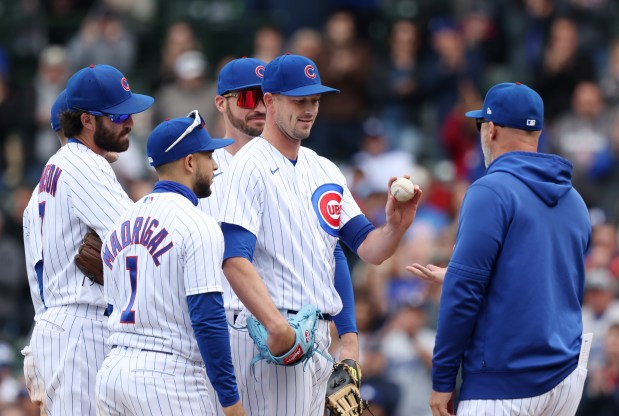MESA, Ariz. — In the quiet moments over the last 4 1/2 months, one recurring theme bothered Chicago Cubs left-hander Drew Smyly the most when he looked back on his 2023 season.
His thoughts typically came back to the same thread woven within his struggles — an inability to stop the bleeding and letting the game get away from him. Smyly owned a 3.27 ERA through 13 starts, then everything started to unravel in mid-June. He posted a 7.83 ERA over his next 10 outings and landed in the bullpen for two weeks before one final ugly start against the Tigers on Aug. 22 prompted a move to the ’pen for the rest of the season.
“I deserved to get kicked out of the rotation,” Smyly told the Tribune on Sunday. “I wasn’t any good for a pretty long stretch and that was probably the first time in my career where I just couldn’t figure it out. I didn’t have an answer.”
If he wants to perform to the level Smyly still believes he’s capable of at 34 years old, he figured he needed to learn a new pitch and add velocity. Smyly’s search for answers brought him to the private training facility Driveline Baseball this offseason.
“I’m getting older, but I still feel like I have better years ahead of me,” Smyly said. “I feel strong. I feel I’m learning more about myself, how to pitch, so I’m excited for this year for sure.”
Smyly had been wanting to check out Driveline for a while — compounded by the urging of his good friend, San Francisco Giants right-hander Alex Cobb, whose career benefitted from working there. But during the last few offseasons, Smyly hadn’t been healthy enough to train in that type of environment, instead needing to recover before the next season.
Smyly got through 2023 healthy and felt strong when the season finished in early October. As young talent continues to come up across the league, Smyly remembered something future Hall of Fame pitcher Max Scherzer told him years ago when they were teammates in Detroit: “You get better or worse every year, it doesn’t matter who you are, how good you are.”
“So I felt like it was the perfect chance for me to get as good as I can be, so I just committed to it,” Smyly said. “Obviously I’m getting to the end of my career and I thought, why not? If they helped me, perfect. If it doesn’t, at least I tried. I gave it my all.”
Drew Smyly, K'ing the Side.
pic.twitter.com/DWze2urAIJ
— Rob Friedman (@PitchingNinja) April 21, 2023
Smyly spent the entire offseason throwing at Driveline’s complex in Scottsdale, Ariz., near his home. He underwent a motion capture session at the facility within four days of the Cubs’ season ending for a biomechanics assessment. Smyly took two weeks off before beginning Driveline’s plyometrics program.
Smyly’s focus with the plyo work centered on two areas: trying to get his body to move faster and increasing velocity. Analysis of Smyly’s biometrics showed he was moving too slowly to the plate. He worked on hip-shoulder separation and trying to be more athletic down the mound. He incorporated five different weighted plyo drills daily.
“My brain always just goes to arm path, arm speed and how can I get my arm right?” Smyly said. “Sometimes you forget the disconnect between your lower half, your legs and your upper body so for me it was very simple.
“I needed that shock to my system, so to speak, and change the way I’ve been training,” Smyly added. “Hopefully I’ll see a lot of gains in velocity. I know I’m in a much better spot throwing harder than I was last spring training so hopefully it’ll carry over and I’ll keep adding velo.”
Eventually, Smyly and the personnel at Driveline worked on pitch design for his repertoire. Most notably, Smyly has added a splitter and slider to his pitch mix. Live batting practice and eventually games will be important indicators of the effectiveness of his splitter. He’s already thrown four live BPs, including three at Driveline.
The splitter became an attractive option after Smyly felt sometimes limited to a fastball-curveball combination, which makes it hard to get through a lineup multiple times. The curveball will always be Smyly’s go-to pitch, but the splitter presents another option to generate whiffs. Driveline personnel were really excited about his splitters metrics, Smyly said, and that it could grade out as one of his best pitches.
“At the same time, until you throw it in games and the hitters are telling you this is a good pitch, I like to pump the brakes a little bit,” Smyly said. “I don’t want to hype it up. But, yeah, it’s something that I obviously need if I want to continue to be a starter. I think it’s going to be a big pitch for me.”
Smyly anticipates throwing his splitter more to right-handed hitters, but if it becomes a pitch he can trust, he believes it will play against lefties too. Unlike his curveball, in which he relies on touch and feel to know how the ball will move out of his hand, the splitter is all about gripping it and ripping it as hard as he can. Game experience and belief in the pitch will be the keys to Smyly’s splitter becoming a pitch he can count on.
“I’m not going to not throw my curveball, but the splitter can help kind of fill in that bridge between my fastball and curveball,” Smyly said.
Smyly also likes the addition of a slider to go away against lefties, who owned dominant reverse splits last year with a .338/.405/.576 slash line off him.
“We’re just tinkering with all of it to see what works and what can stick, but I am excited about those pitches,” Smyly said.
Smyly has an opportunity to claim the final spot in the Cubs rotation and begin the season as a starter. Counsell told him the Cubs want him to get stretched out and then at some point in the middle of camp the team will make a decision whether he continue to build up or prepare to pitch in relief.
Smyly appreciates Counsell and the front office giving him a chance in camp to show he can still be a big-league starter while also knowing they value him as a reliever, a role in which he posted a 3.00 ERA in 14 appearances during the final five weeks of last season.
“In my eyes, I’m one of the best pitchers and I know I’m capable of handling that job, I’ve done it my whole career,” Smyly said. “Either way, they know how I just want to win and I think they’re excited that I take some pride in my versatility.”
Counsell didn’t want to give a specific number of players who are competing for the fifth rotation spot, instead explaining how the bullpen is built could impact which direction the Cubs go at the start of the year. The Cubs certainly have options if they want relievers capable of throwing multiple innings or even spot starts if needed with Smyly, Javier Assad and Hayden Wesneski all filling both roles last year.
Counsell and the Cubs know they will need more than five starters to get through the season. Roster construction will play a role in the decision. They want to make sure they possess adequate depth and have starters ready as needed.
“Giving everybody some time here and seeing how some guys kind of emerge, that’ll give us a pretty good idea about Drew,” Counsell said Sunday. “Every team is going to stretch out the guys that can start right now and that’s just the smart thing to do. And we’re going to delay that decision as long as we possibly can.”





